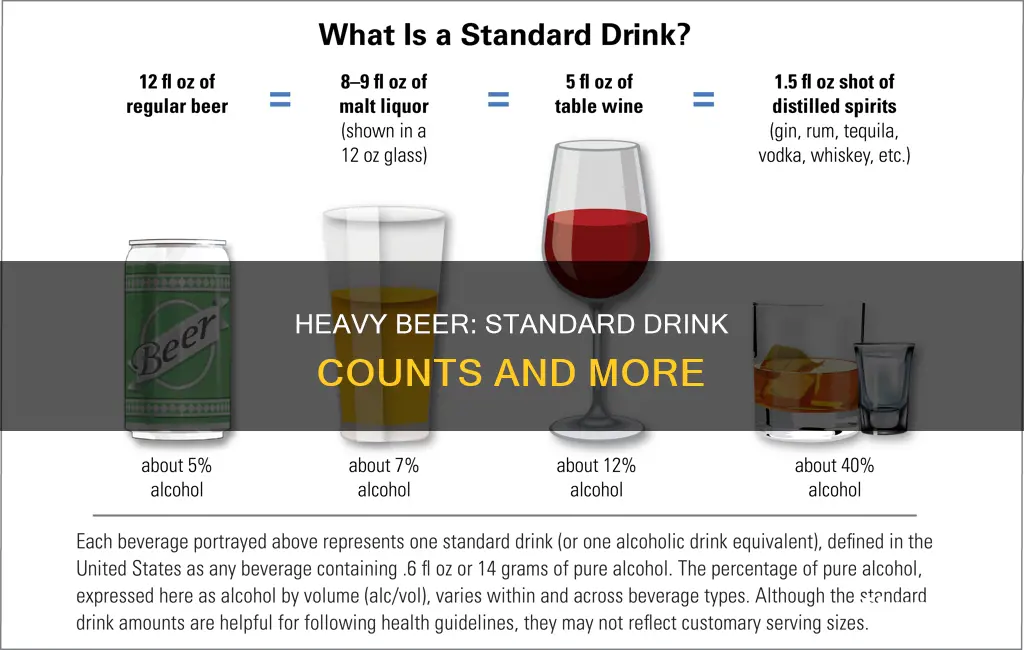
A standard drink is a way to measure alcohol intake, as drinks vary in size and strength. A standard drink always contains 10g of pure alcohol. This is important to know, as health experts recommend no more than 4 standard drinks a day and no more than 10 a week. Each drink can increase the risk of injury and accidents and negatively impact long-term health. So, how many standard drinks are in a heavy beer?
What You'll Learn

A standard drink in the US
In the United States, a "standard drink" is defined as any beverage containing 0.6 fluid ounces or 14 grams of pure alcohol. This is also known as an alcoholic drink equivalent.
The amount of liquid in a glass, can, or bottle does not necessarily reflect how much alcohol is in a drink. Different types of beer, wine, or malt liquor can have varying alcohol content. For example, many light beers have almost as much alcohol as regular beer, with light beers containing about 4.2% alcohol, and regular beers containing about 5%.
The following drinks are all examples of one standard drink, despite their different volumes:
- 12 fl oz of regular beer
- 8–10 fl oz of malt liquor or flavored malt beverages such as hard seltzer
- 5 fl oz of table wine
- 3–4 fl oz of fortified wine (such as sherry or port)
- 2–3 fl oz of cordial, liqueur, or aperitif
- 1.5 fl oz of brandy or cognac (a single jigger)
- 1.5 fl oz shot of distilled spirits (gin, rum, tequila, vodka, whiskey, etc.)
The percentage of pure alcohol, expressed as alcohol by volume (alc/vol), varies within and across beverage types. Although the standard drink amounts are helpful for following health guidelines, they may not reflect customary serving sizes.
Beer Benefits: Why Drinking Beer is Good for You
You may want to see also

Alcohol by volume (ABV)
Alcohol by volume, or ABV, is a standard measure of the volume of alcohol in an alcoholic beverage. It is defined as the number of millilitres (ml) of pure ethanol present in 100 ml of solution at 20°C. The number of millilitres of pure ethanol is the mass of ethanol divided by its density at 20°C, which is 0.78945 g/ml. ABV is used worldwide and is helpful in determining the level of alcohol content in a drink.
A standard drink is always equal to 10 grams of pure alcohol. The ABV of a craft beer, wine, or liquor is one of several metrics that can help you determine what you put in your body when you consume alcohol. A glass of beer with 2% ABV has less alcohol content than a glass of wine with 10% ABV. You will probably feel the effects of the higher-ABV wine faster than the lower-ABV beer. 4% ABV is considered low in the craft beer world.
The ABV of a drink can also indicate how it might taste. Alcohol content can impact the flavour of a drink. Drinks with higher alcohol content are usually more bitter than low-ABV drinks. Dark beers, for example, will likely have a higher ABV than lighter beers and will taste stronger.
The ABV of a drink can also help you understand how it will affect your body. A high-ABV drink will affect your body more quickly than a low-ABV drink. It may take a few 5% ABV beers before you start to feel the effects, but just one shot of a 40% ABV liquor may be enough to make you feel woozy because your body can't process that much alcohol as quickly.
The ABV of beer typically ranges from 4% to 7%, with an average of 5%. Wine tends to have a higher alcohol content, ranging from 10% to 15%, with many clustering around 11% to 13%. Liquor has the highest alcohol content, ranging from 20% to 60% ABV, with vodka potentially reaching 95% ABV.
Beer and Pancreatitis: What You Need to Know
You may want to see also

Alcohol content in cocktails
The alcohol content of cocktails varies depending on the type and volume of alcohol and mixers used. For example, a Mai Tai has approximately 17.7% alcohol, while a Rum and Coke has approximately 13.3% alcohol.
The alcohol content of a cocktail can be calculated using the following formula:
Volume of Alcohol x ABV%) / Sum of Ingredients) x 100 = % Alcohol by Volume
For example, if you are making a cocktail with 45ml of 40% ABV rum, 30ml of pineapple juice, 15ml of lime juice, and 60ml of ice/water, the alcohol content would be:
45 x 0.4) / 150ml) x 100 = 12%
This formula can be adjusted to account for dilution from ice and shaking, which can add approximately 30ml of water to a drink. It's important to note that the size of the glass and the volume of mixers can also affect the alcohol content of a cocktail.
When creating a new cocktail, balance is crucial. A common mistake is to make a cocktail with an alcohol content that is way out of proportion, which can be unpleasant to drink. A well-balanced cocktail typically has an alcohol content similar to that of wine, which is around 12-14%.
Additionally, the alcohol content of cocktails can vary depending on the bartender and their pouring style. Some bartenders may pour a 2-ounce shot of liquor, while others may prefer 1.5 ounces. This can significantly impact the overall alcohol content of the cocktail.
It's worth noting that the alcohol content of liqueurs can also vary between brands, even between liqueurs of the same style or flavor. For example, some triple sec liqueurs may have an ABV of 30%, while others may have an ABV of 40%. This can affect the overall alcohol content of a cocktail, so it's important to check the labels and adjust the recipe accordingly.
Overall, while it can be challenging to determine the exact alcohol content of a cocktail due to various factors, understanding the basic formula and the importance of balance can help create well-proportioned and enjoyable drinks.
Beer and Ciprofloxacin: Is It Safe to Mix?
You may want to see also

How to calculate standard drinks in common containers
To calculate standard drinks in common containers, you need to know two things: the volume of the drink (measured in ounces or milliliters) and the alcohol content by volume (shown as % ABV or 'proof'). With these two pieces of information, you can calculate how many standard drinks are in a container.
A standard drink is a way to measure how much alcohol you consume, as drinks come in different sizes and alcohol concentrations. A standard drink is always equal to 10 grams of pure alcohol.
For example, a 21-fluid ounce beer contains 1.8 standard drinks, while a 40-fluid ounce bottle of malt liquor contains 4.7 standard drinks. A "half-pint" (200 ml) of 80-proof distilled spirits contains 4.5 standard drinks, and a "half-bottle" (375 ml) of the same alcohol contains 8.5 standard drinks.
It's important to note that the alcohol content of different types of beer, wine, and other beverages can vary, so it's always good to check the label or do some research to get an accurate idea of how many standard drinks you're consuming. Online calculators and resources are available to help you calculate the number of standard drinks in various beverages.
Additionally, serving sizes may differ from the typical alcohol concentrations listed. For example, a regular beer (5% alc/vol) in a 750 ml bottle is approximately 5 standard drinks, but the number of standard drinks will vary depending on the volume and alcohol content.
The Science of Beer Tubes: How Do They Work?
You may want to see also

How to calculate standard drinks in beer bottles and cans
A standard drink is a way to measure how much alcohol you're consuming. It's important to note that a standard drink (10 grams of alcohol) is not the same as a glass of wine or a bottle of beer. Drinks come in different sizes and alcohol concentrations, so it's essential to calculate the number of standard drinks in each beverage. This is especially crucial when drinking beer from bottles or cans, as the alcohol content can vary significantly.
To calculate the number of standard drinks in a beer bottle or can, you need two key pieces of information: the volume of the container (in ounces or milliliters) and the alcohol content by volume (often displayed as % ABV or 'proof'). With these two values, you can use a standard drink calculator to determine the number of standard drinks.
For example, let's consider a 12-ounce can of beer with 5% ABV. Using a standard drink calculator, we can find out how many standard drinks it contains. According to the calculator, this can of beer contains approximately 1.2 standard drinks.
Now, let's take a different beer as an example: a 24-ounce bottle of craft beer with 7% ABV. Using the same standard drink calculator, we find that this bottle contains approximately 2.4 standard drinks.
It's important to note that the serving size and alcohol concentration of beer can vary widely, so it's always a good idea to check the label or use a calculator to determine the exact number of standard drinks. Additionally, recommendations for alcohol consumption are typically given in terms of these standard servings, so it's useful to be able to make these conversions.
Beer and Homeopathy: Is It Safe to Mix?
You may want to see also
Frequently asked questions
This depends on the strength of the beer and the volume of the container. A heavy beer in a 375ml can or bottle is approximately 1.5 standard drinks, while a heavy beer in a 425ml container is approximately 1.7 standard drinks.
A standard drink is defined as any drink containing 14 grams, or about 0.6 fluid ounces, of "pure" ethanol. This amount of alcohol is typically found in 12 ounces of regular beer, 5 ounces of table wine, or 1.5 ounces of distilled spirits.
You can check the drink label, use a standard drinks calculator, or ask the staff at the bar or restaurant. It's important to note that the drinks you consume may contain more alcohol than you think, so it's always better to overestimate your consumption rather than underestimate it.







